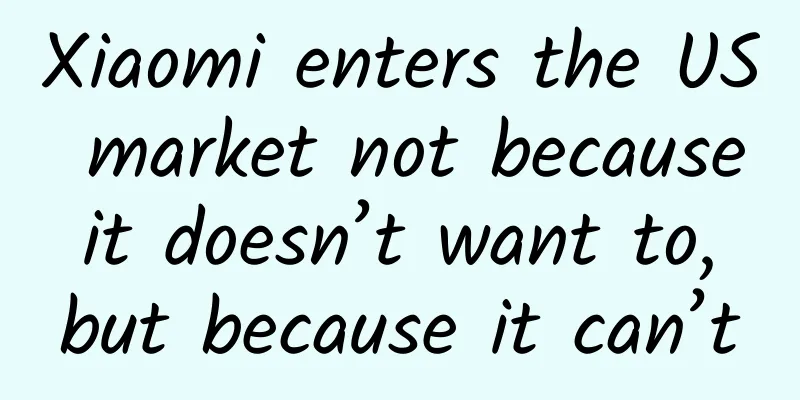Xiaomi enters the US market not because it doesn’t want to, but because it can’t

|
Xiaomi senior vice president Wang Xiang said in an interview that they are not yet ready to sell mobile phones in the US market. The previous global vice president Hugo Barra once said that mobile phones might be sold in the US market this year. This can only be said that Xiaomi does not want to sell mobile phones in the US market, but because of the lack of sufficient patents, it dare not take the risk of selling mobile phone products in the US market. The U.S. market is the most valuable smartphone market in the world. Apple and Samsung, which currently account for more than 90% of the global mobile phone industry's profits, have a dominant market share in the U.S. market. The two brands together account for about 70% of the smartphone market in the United States. Several Chinese mobile phone brands such as Huawei, ZTE, Lenovo, and TCL have tried hard to enter the US market, but ZTE has been the most successful, ranking fourth in market share. Huawei, the largest domestic and third largest mobile phone brand in the world, has found it difficult to enter the market due to various factors. Xiaomi became the world's third largest and China's largest mobile phone brand in the third quarter of 2014, and began to enter overseas markets at that time. Currently, Xiaomi's best overseas market is India, but it has also experienced many twists and turns. After Xiaomi entered the Indian market in 2014, it developed rapidly and made good use of the fast-growing local e-commerce market. In the fourth quarter of the same year, it won the fifth place in the Indian smartphone market. However, at the end of the year, it encountered a patent lawsuit from Ericsson that demanded a ban on the sale of Xiaomi mobile phones in the market. However, with the help of Qualcomm's patent license, the ban was quickly lifted, and mobile phones using Qualcomm chips can continue to be sold in the market, but mobile phones using MediaTek chips are still banned. Afterwards, Xiaomi cooperated with Foxconn to build a manufacturing plant in India to meet the requirements of India's manufacturing, and localized the manufacturing of Xiaomi mobile phones. After some efforts, it finally began to grow in the second quarter of last year, and its market share rebounded from the previous seventh place to the third place in the fourth quarter of last year (tied with Lenovo). While entering the Indian market, Xiaomi also began to enter the US and Brazilian markets. Brazil is the hometown of Hugo Barra, the former global vice president of Xiaomi. Xiaomi originally hoped to make a big splash in this market, but due to the complex local economic environment and other factors, it eventually withdrew its Brazilian team in the first half of last year. Xiaomi entered the US market by opening an online store in the market to sell accessories such as headphones and batteries. At the end of 2015, Xiaomi 4 and other mobile phones obtained the US FCC certification. All parties believed that it would officially sell mobile phones in the US market. However, not long after Xiaomi 4 passed the US FCC certification, it encountered a patent lawsuit. As a result, the US virtual operators quickly removed Xiaomi's mobile phones from the shelves. This made Xiaomi realize how strict the US market's management of intellectual property rights is. Since then, Xiaomi has begun to pay more attention to intellectual property management. In addition to stepping up its own patent applications, it has also reached patent licensing cooperation with Intel, Microsoft and other companies, and acquired some patents from these two companies. However, it is not easy to obtain enough patents. It is probably difficult for it to accumulate enough patents to deal with all parties in just over a year of operation. Moreover, patent litigation requires a lot of energy and funds. At present, when its domestic market is constantly being eroded by its competitors, it is not suitable for multi-line operations. In addition to the European and American markets with strict intellectual property management, there are also vast markets such as India, Southeast Asia, Africa, Russia, etc. Therefore, it is a more appropriate choice for Xiaomi not to enter the US market for the time being. It is a more appropriate choice to concentrate on operating these developing country markets and then gradually enter the European and American markets. As a winner of Toutiao's Qingyun Plan and Baijiahao's Bai+ Plan, the 2019 Baidu Digital Author of the Year, the Baijiahao's Most Popular Author in the Technology Field, the 2019 Sogou Technology and Culture Author, and the 2021 Baijiahao Quarterly Influential Creator, he has won many awards, including the 2013 Sohu Best Industry Media Person, the 2015 China New Media Entrepreneurship Competition Beijing Third Place, the 2015 Guangmang Experience Award, the 2015 China New Media Entrepreneurship Competition Finals Third Place, and the 2018 Baidu Dynamic Annual Powerful Celebrity. |
<<: Having more sons is good for fighting. Can Chery Jetour X70 help Chery turn things around?
Recommend
Download the full set of "Uncle Kai's Sound and Rhythm Enlightenment" audio and listen online to Baidu Netdisk sharing address
Download the full set of "Uncle Kai's So...
What will happen if you eat a box of blueberries every day? Will your skin really become whiter? Will your eyesight really improve?
In recent years, as a fruit with high nutritional...
The eruption of a volcano thousands of miles away actually gave the northern hemisphere a chill in the summer
The unexpected appearance of the "fish chase...
【Fire safety】What fire safety knowledge do you need to know in your daily life? Please save it!
Do not plug too many plugs into one electrical ou...
Baidu bidding promotion account structure
For bidding promotion, a healthy account structur...
Southerners vs Northerners, who is fatter? The truth is...
People in the south are thinner than people in th...
Messaging apps will become the next generation of Internet portals
[[126960]] The New York Times wrote that the func...
Li Zhongying's video lecture on "Children's Learning Ability and Effect"
Course Contents: 01. Mental state 01.What can par...
Douyin Training Camp Project Practice (Operation)
As the pressure of employment competition becomes...
Brand marketing promotion: How to increase tens of millions of users in 60 days?
Recently, some groups have been forwarding a mess...
Momo’s paying users have surged. What’s the operational growth logic behind it?
When it comes to Momo, many people still think of...
The mortality rate is extremely high! This bacteria can "eat meat", so be careful in summer!
Produced by: Science Popularization China Author:...
How Apple turned Android into a hardware guinea pig!
Some people say that in Jobs' vision of chang...
Exclusive interview with Li Lanjuan: Can humans eventually defeat the new coronavirus? Technology is the key to fighting the epidemic
The epidemic is really affecting our lives. In th...
Which market makes the most money? Tencent tells you!
[[127236]] The Investment and M&A Department ...









